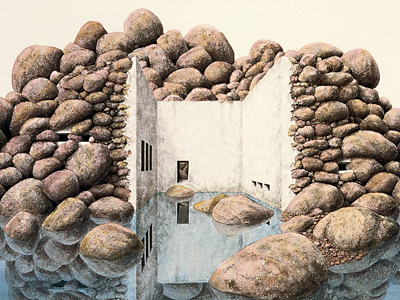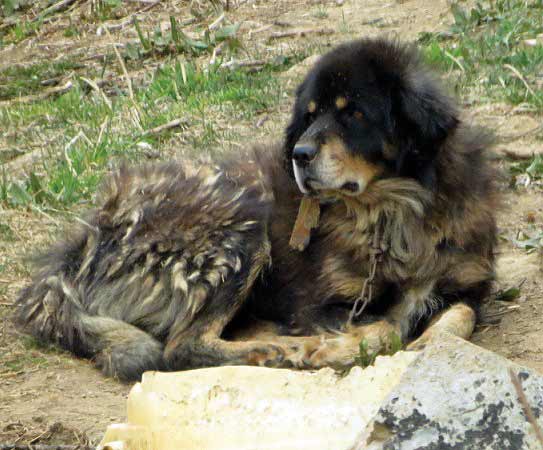Robert Powell, better known as Rob to the people that are familiar with him, is a long time resident of Kathmandu, and a familiar figure to many people that live and work here. For those that might not have heard about this quiet gentlemen from Australia, who was smitten by the Nepal bug about twenty years ago and has been here since, here is a brief introduction to the man and his work.
 Born in 1948 in Sydney, Australia, Robert Powell trained as an architect at the University of New South Wales after completing his graduation there in English and Psychology. He left Australia in 1974 to travel to Asia - after a visiting troupe of traveling musicians from Bengal, called Bauls, invited him over to stay with them in Bengal, India. Traveling to India, Pakistan and Nepal during the years that followed, Robert gradually moved from being an architect to an artist but when and how is not defined by any seminal moment - more the gradual transformation of – or rather the merging of – an architect with an artist. The 70’s he spent more in the world of architecture, as he worked with architectural firms abroad during those years and it was only from the 80’s onwards that his connection with Nepal strengthened, though his traveling to places that are featured in his work encompass a period starting from the 70’s itself. In Nepal, he has been involved in various architectural projects like the Machan Resort in Chitwan, the Fulbari Resort in Pokhara and the Janakpur Womens Development Centre in Janakpur. While working on all these projects however, he has still managed to produce a fairly large collection of paintings that have earned him the reputation of a painter, and he is currently known more for his paintings than for his involvement in architecture.
Born in 1948 in Sydney, Australia, Robert Powell trained as an architect at the University of New South Wales after completing his graduation there in English and Psychology. He left Australia in 1974 to travel to Asia - after a visiting troupe of traveling musicians from Bengal, called Bauls, invited him over to stay with them in Bengal, India. Traveling to India, Pakistan and Nepal during the years that followed, Robert gradually moved from being an architect to an artist but when and how is not defined by any seminal moment - more the gradual transformation of – or rather the merging of – an architect with an artist. The 70’s he spent more in the world of architecture, as he worked with architectural firms abroad during those years and it was only from the 80’s onwards that his connection with Nepal strengthened, though his traveling to places that are featured in his work encompass a period starting from the 70’s itself. In Nepal, he has been involved in various architectural projects like the Machan Resort in Chitwan, the Fulbari Resort in Pokhara and the Janakpur Womens Development Centre in Janakpur. While working on all these projects however, he has still managed to produce a fairly large collection of paintings that have earned him the reputation of a painter, and he is currently known more for his paintings than for his involvement in architecture.
So what turned Robert to painting? There is no definite time, according to him, that he decided to become a painter instead of an architect. Though trained for architecture, he began his travels in Asia in the 70’s and in that time traveled to Nepal, India, Afghanistan and did the de rigueur overland trip to Europe. It was during this time that Robert started sketching what he saw and experienced as an architect and traveler. A part of the reason for that he attributes to the fact that Australia, being a fairly new nation, there is not much in terms of architectural heritage. This was in stark contrast to his Asian experience where the architectural heritage was both rich as well as varied and which he found fascinating. This sparked in Robert an interest in drawing and he started his artistic career sketching these images that so fascinated him. Although he worked with an architectural firm during the 70’s, it was not a full time experience and he divided his time between architecture and his travels and discovery of Asia. He was amongst the first foreigners to enter Ladhak when it opened to foreigners in 1974, and tells us he was on the first bus there! Some of his sketches from this time are to be found in the book ‘Himalayn Drawings’ by Robert Powell.
In 1980-he came to Nepal and through a series of unplanned events, he ended up staying here. It was also in 1980 that he held his first exhibition at the Hotel Vajra in Kathmandu, and in a sense it is the point when one can begin to define him as an artist. Or rather, it was the time that he began to explore himself as an artist.
Although his works cover a large swathe of Himalayan architecture and locations, some of the best and perhaps most popular paintings done by Robert Powell are of the Mustang area. These paintings are characterized by their stark simplicity and the careful attention to detail. The details in the paintings are almost to technical specifications and his architectural training is apparent in the way the forms and construction of the buildings comes out – including his attention to scale. Robert calls these paintings imaginary documentation and in a way this relates to the pre-photographic era when places and scenes were represented in sketches and paintings, with the artist’s own influence in the representation of the scene. Roberts form of art combines documentary techniques with artsitic inputs, with the end result being an interesting work of art.
So what is it that Robert represents or tries to express through his paintings? With imaginary documentation, Roberst says he tries to firstly document the things that he paints – usually manmade constructions where the Mustang paintings are concerned – and then tries to bring out through his painting what would not be possible with photography or even just technical drawing. In a way, his paintings merge architectural scale drawings with photographic representation and by using water colors to do his works – his chosen medium – he gives each piece a clarity and feel that neither could give on their own. This feeling, according to Robert, is of the power of the structures. The structures and the landscapes he documents through his paintings convey to him a sense of power and beauty, and this he represents, quite effectively , through the stark paintings that are his hallmark.
So is his documentation art? Robert, when asked, says he now sees himself more as an artist than as an architect. But then, architecture could also be art and so perhaps he was always an artist who has now found his medium. His paintings certainly please the eye but it also often feels incomplete. The blank background is deliberate on his part, in order to focus attention on his painting, but that fact that it makes you feels something makes it more than mere drawing, and perhaps this is the art in his works.
Living in Naxal with his wife Lieve, a yoga instructor well known in the local community, Robert spends most of his day painting in his second floor studio, listening to what he calls an eclectic mix of music, the presence of Celiene Dion amongst which he notes to be an accident (apologies to her fans!). His residence seems to reflect his paintings in the stillness and simplicity that it has. His studio by contrast is a jumble of objects and feels like a creative center might feel, or should feel – brimming with potential activity.
What future directions does he see himself heading towards? Robert says that he does not plan his life that way and he does not really see himself heading in any particular direction at all as an artist. Currently he is engaged in a project for a Chinese foundation and this will culminate in an exhibition to be held next March in Hong Kong and New York, where he will be displaying paintings of a region in China, with buildings of the Ming dynasty. He still has a couple of Mustang paintings up his sleeve though, and says he hopes to be able to produce them over the next few years.
What is apparent is that Robert is someone who is fascinated by the architecture of the Himalayas and through his paintings, he has not only created a certain positive awareness about the architecture of Mustang and other regions, he has also contributed towards their preservation. Robert Powell the artist, through his imaginary documentation, has brought Himalayan architecture into the world of art.









